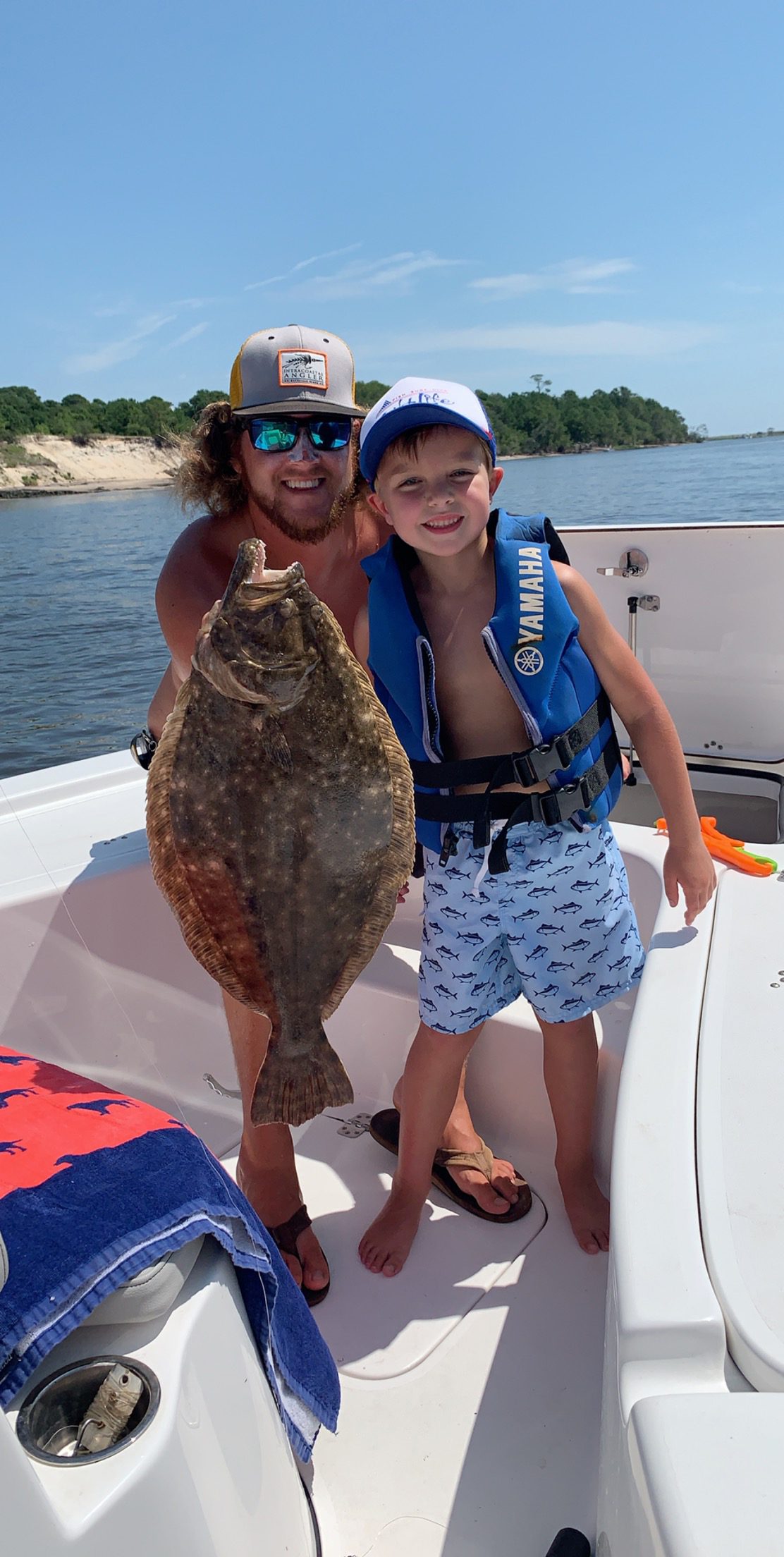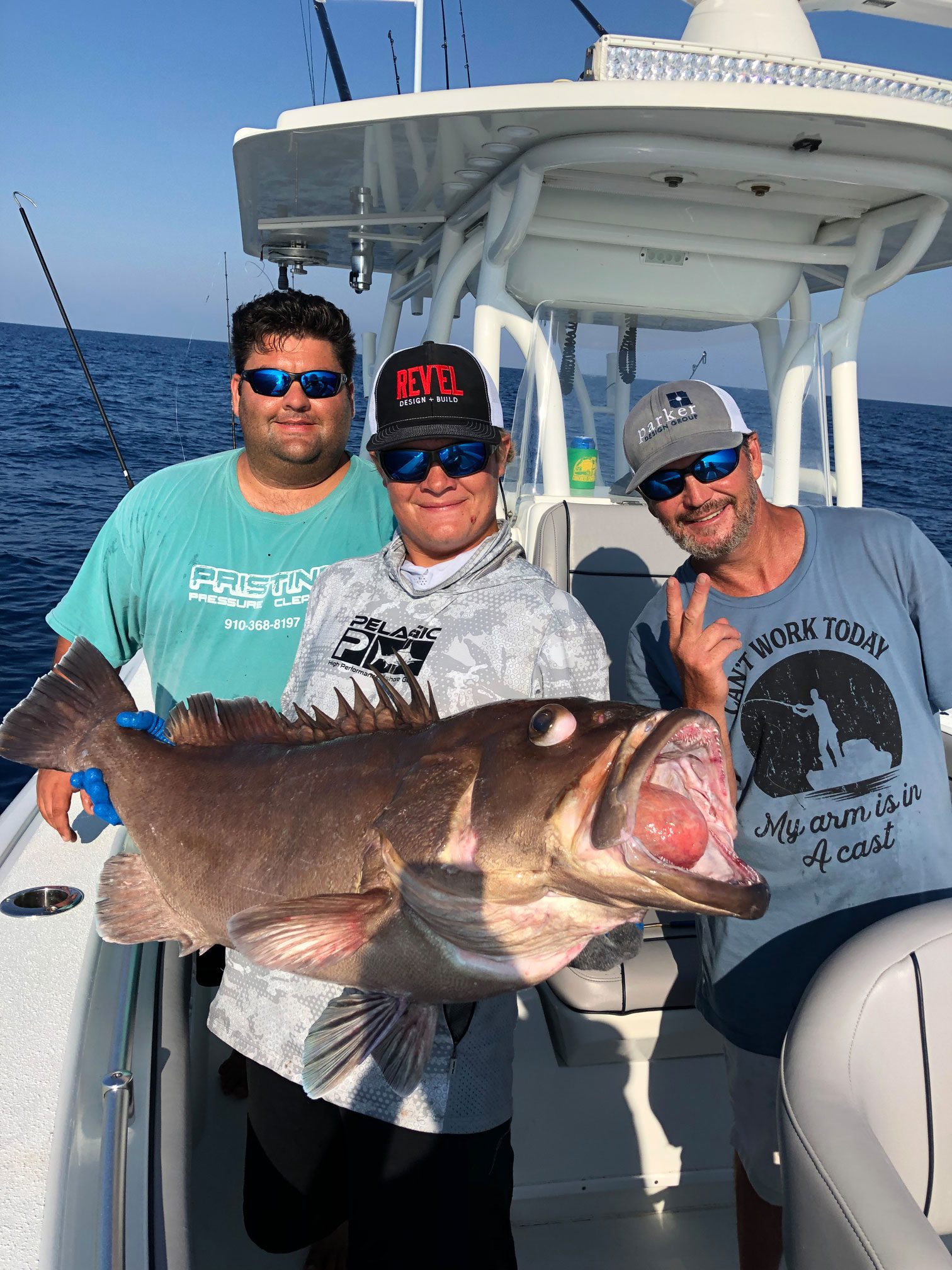Carolina Beach – July 18, 2019
Lewis, of Island Tackle and Hardware, reports that there are a few trout in the creeks, and they’re mostly biting Z-Man and Gulp shrimp.
Redfish have been on the oyster beds, where they’re happy to strike Carolina-rigged mullet and topwater lures.
Flounder are spread out around the creeks and in the inlet. They’ll fall for both mullet and pogies.
A few black drum and sheepshead have been caught under the bridge on fiddler crabs.
Nearshore wrecks are producing flounder for anglers fishing mullet and pogies. Some spanish and kings are biting spoon/planer combos an and around these same nearshore areas.
Offshore, wahoo and dolphin are chasing skirted ballyhoo, while a few blackfins have been caught on trolled cedar plugs.
On the bottom, cigar minnows and squid have produced plenty of black sea bass, gag grouper, beeliners, and triggers.

Carter Creech (age 6) with a 27″, 8.6 lb. flounder that fell for a live finger mullet in 15′ of water near Carolina Beach. He was fishing with Bryan Armstrong.
Christian, of Seahawk Inshore Fishing Charters, reports that most of the reds are holding in deeper water and shallow bays in the lower part of the Cape Fear River. The majority are lower- to mid-slot fish, with an occasional upper-slot mixed in.
Fishing live bait on the bottom with Carolina rigs is producing the most fish. Mullet minnows have finally shown up and are plentiful on most days. Their improved presence has made them the best baits to use. Mud minnows are also a good option, with some soft plastics working as well.
Some flounder are eating live baits and artificials on the incoming and outgoing tides. Scented plastics have worked best, and creek mouths and shallow drop-offs seem to be holding the majority of these fish. Mud minnows, finger mullet, and menhaden all work great. Most fish are small, but some keeper fish in the 16-20” range are coming in the boat.
Scattered speckled trout have been caught along with the reds and flounder. Finger mullet fished similarly to the reds and flounder has been working best.
Luke, of Spot On Charters, reports that the flounder bite is still on fire, with good numbers of 2-3 lb. fish coming in from Snow’s Cut, as well as the Cape Fear River from Southport all the way to downtown Wilmington. When fishing the river, it’s vital to do it on a falling tide, as flounder don’t bite in a slow current. Lower temperatures have kept the fish in shallower water, and first light is the best time to try and find fish.
Nearshore wrecks are holding plenty of keeper flounder, with an occasional over-slot red drum mixed in. Live bait will bring in most fish, but if live bait isn’t available, then bucktails tipped with Gulp is a good option.
Bait has been tricky, as the area mullet have been a little too small and the pogies have been a little too big.
The red drum bite continues to be good near the river mouth in Southport and in the Bald Head Island area, though some nice fish are starting to bite a little farther upriver. Most of the reds have been mid- to over-slot.
Trout have been biting topwater lures on first light. The average size has been 2-3 lbs., but there have been some citation fish mixed in as well.

Tommy Rechichar, Colin York, and Brian Rowley with a 55 lb. snowy grouper that fell for a dead Boston mackerel 87 miles out of the Cape Fear River mouth.
Luke, of Coastline Charters, reports that fishing has rolled right into the summer patterns. Expect red drum on topwater early and late in the day. Finger mullet on Carolina rigs near docks, oyster beds, and grass lines are producing decent numbers of reds. Soft plastic Z-Man products on a Blue Water Candy jig head are producing good action as well.
There are more flounder showing up inside every day. Carolina-rigged finger mullet in the same target areas holding red drum will also be holding the flatties. Some flounder are still on the small side, although there has been much better numbers of larger flatfish in the mix.
There are still good numbers (and sizes) of flounder just off the beach, too, where live baits and bucktails are catching fish.
The sheepshead bite remains decent, with fiddler crabs as the bait of choice.
There are spanish mackerel just off the beach, though the warm water has seemed to push the spanish off a little. Trolling Clarkspoons is the best option.
Rod, of OnMyWay Fishing Charters, reports that spanish are still biting off the beach, though their range has increased to about 20-45’+ of water. Look for them from the mid-point of the falling tide until the end, as the rising tide makes for tougher fishing.
Clarkspoons have been working as always, but to mix things up, try trolling with a Big Nik Spanish Candy lure. While typically used for casting, the lure can be dragged behind the boat to produce incredible numbers of fish.
Kings have been biting between 25-30 miles, with boat limits being caught 75% of the time. Drone spoons (size 3.5) in pink with chartreuse tape have been attracting plenty of attention, and you can troll them fast or slow. Work ledges, bait, and live bottoms, and be patient (especially when fishing near bait). Slow trolling dead bait has been the most productive, but live bait is working as well.
Mahi have been mixed with the kings, particularly in the 15 mile and out range. If you can find some of the scattered weed lines in that area, you will find fish. An overabundance of flying fish in the same areas means that sailfish should be biting there very soon, too.
Bottom fishing within 30 miles has produced some big black sea bass, though you have to wade through plenty of smaller fish to find them. Gag grouper can be found in this range as well. Beyond 30 miles, you can take advantage of an on-fire scamp and red grouper bite, and don’t be surprised to pull up plenty of 3 lb. beeliners as well.
The 40 Mile Rock and WR2 have been providing a lot of great mahi fishing, but the Gulf Stream has been slow. Looking for cobalt blue water is preferable, as opposed to blue-green.
Woody, of Kure Beach Pier, reports that blues, flounder, and spanish have all been in the mix. Most everything but the spanish have been caught on shrimp in the early mornings.





